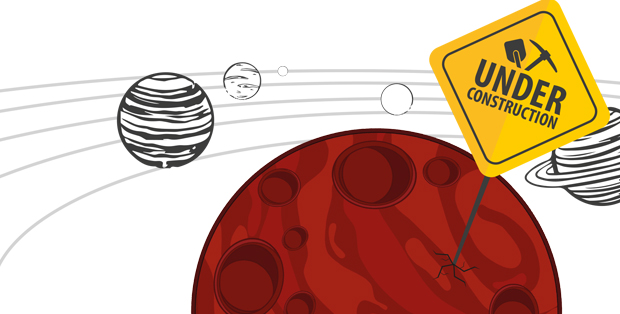At the end of last year, Elon Musk, tech billionaire and founder of SpaceX, made quite the ambitious proclamation: by 2022, he posited, manned missions to Mars will see the light of day. With a vision to make life as we know it “interplanetary,” Musk’s ambitions have been met with intrigue, if not reluctance. But what if his master plan for humanity weren’t so far-fetched after all? What if, in our very own lifetimes, a trip to Mars were suddenly a viable bucket-list item? Would you sign up?
A group of researchers from Northwestern University took the thought a step further. Vehemently convinced that commercial travel to the red planet is not a matter of “if” but rather “when,” they’ve taken it upon themselves to get the ball rolling on the logistics front. Namely, as it pertains to infrastructure. And what screams infrastructure more than concrete? Nothing, really. On Earth, anyway. But on Mars, it’s a different story. Let’s have a look at the caveats of building on the red planet, and the solution the researchers propose for a smooth human integration once there.
No H₂0, no go
Concrete abounds on the planet we call home. From the Romans and Egyptians who put themselves on the map thanks to it, to modern-day metropolises battling it out in the high-rise construction space, concrete is king – so much so, that in the course of a single year, two billion tons of the good stuff are produced, and that number is only expected to rise in the not-so-distant future.
So now we bet you’re asking yourself: why not just make concrete on Mars, then? If only it were that easy. You may remember from this recent blog post that one of the main ingredients in concrete is water. Well, it turns out that, on the red planet, water is not exactly in abundance. But not ones to let a small hurdle like that deter them, the team from Northwestern experienced a lightbulb moment: why not replace water with sulphur?
Martian concrete: water’s out, sulphur’s in
When on Mars… it’s vital to use resources that are readily available. Since water is not one of them, the team set their sights on one that is – sulphur. Their method goes a little something like this: heat the sulphur to 240°C so that it becomes liquid, mix it with Martian soil (a mixture of titanium dioxide, iron oxide, silicon dioxide, aluminum oxide, among other components), which acts as an aggregate, and let it cool. The sulphur solidifies, binding the aggregate and magically creating concrete – of the Martian variety!
To test out their method, the researchers got their hands dirty, of course. And their findings were impressive – it was determined that the best mix for producing Martian concrete is 50% sulphur and 50% Martian soil with a maximum aggregate size of 1mm (the smaller the particles of the aggregate, the fewer the voids, and the greater the compressive strength). And with a compressive strength in excess of 50 MPa, it’s safe to say that structural integrity would not be compromised. Another interesting bit they unearthed: Martian concrete is recyclable! Simply heat it so that the sulphur melts and re-use over and over as you see fit. It’s also significantly cheaper than materials brought from Earth would ever be, something that may just tip the scale in favour of sulphur as building material of choice.
So, where do you see yourself in five years? On a manned mission to Mars, perhaps?
Sources:
https://www.technologyreview.com/s/545216/materials-scientists-make-martian-concrete/
https://phys.org/news/2016-01-martian-concrete-materials-red-planet.html





